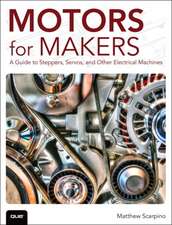Kinematic Modeling, Identification, and Control of Robotic Manipulators: The Springer International Series in Engineering and Computer Science, cartea 29
Autor Henry W. Stoneen Limba Engleză Hardback – 30 sep 1987
| Toate formatele și edițiile | Preț | Express |
|---|---|---|
| Paperback (1) | 942.44 lei 43-57 zile | |
| Springer Us – 23 noi 2011 | 942.44 lei 43-57 zile | |
| Hardback (1) | 948.79 lei 43-57 zile | |
| Springer Us – 30 sep 1987 | 948.79 lei 43-57 zile |
Din seria The Springer International Series in Engineering and Computer Science
- 24%
 Preț: 1041.97 lei
Preț: 1041.97 lei - 20%
 Preț: 643.50 lei
Preț: 643.50 lei - 18%
 Preț: 1225.62 lei
Preț: 1225.62 lei - 18%
 Preț: 965.02 lei
Preț: 965.02 lei - 20%
 Preț: 646.12 lei
Preț: 646.12 lei - 18%
 Preț: 948.79 lei
Preț: 948.79 lei - 20%
 Preț: 646.62 lei
Preț: 646.62 lei - 15%
 Preț: 637.46 lei
Preț: 637.46 lei - 20%
 Preț: 643.83 lei
Preț: 643.83 lei - 18%
 Preț: 949.23 lei
Preț: 949.23 lei - 20%
 Preț: 644.48 lei
Preț: 644.48 lei - 20%
 Preț: 994.92 lei
Preț: 994.92 lei - 20%
 Preț: 645.97 lei
Preț: 645.97 lei - 18%
 Preț: 946.87 lei
Preț: 946.87 lei - 20%
 Preț: 995.57 lei
Preț: 995.57 lei - 18%
 Preț: 956.99 lei
Preț: 956.99 lei - 20%
 Preț: 644.98 lei
Preț: 644.98 lei - 15%
 Preț: 649.54 lei
Preț: 649.54 lei - 18%
 Preț: 950.21 lei
Preț: 950.21 lei - 18%
 Preț: 1221.38 lei
Preț: 1221.38 lei - 18%
 Preț: 957.62 lei
Preț: 957.62 lei - 15%
 Preț: 643.99 lei
Preț: 643.99 lei - 18%
 Preț: 948.47 lei
Preț: 948.47 lei - 18%
 Preț: 947.35 lei
Preț: 947.35 lei - 20%
 Preț: 1284.65 lei
Preț: 1284.65 lei - 20%
 Preț: 1633.95 lei
Preț: 1633.95 lei - 20%
 Preț: 1285.78 lei
Preț: 1285.78 lei
Preț: 948.79 lei
Preț vechi: 1157.06 lei
-18% Nou
Puncte Express: 1423
Preț estimativ în valută:
181.55€ • 190.03$ • 151.11£
181.55€ • 190.03$ • 151.11£
Carte tipărită la comandă
Livrare economică 31 martie-14 aprilie
Preluare comenzi: 021 569.72.76
Specificații
ISBN-13: 9780898382372
ISBN-10: 0898382378
Pagini: 224
Ilustrații: XXII, 224 p.
Dimensiuni: 156 x 234 x 19 mm
Greutate: 0.54 kg
Ediția:1987
Editura: Springer Us
Colecția Springer
Seria The Springer International Series in Engineering and Computer Science
Locul publicării:New York, NY, United States
ISBN-10: 0898382378
Pagini: 224
Ilustrații: XXII, 224 p.
Dimensiuni: 156 x 234 x 19 mm
Greutate: 0.54 kg
Ediția:1987
Editura: Springer Us
Colecția Springer
Seria The Springer International Series in Engineering and Computer Science
Locul publicării:New York, NY, United States
Public țintă
ResearchCuprins
1. Introduction.- 1.1. Overview.- 1.2. Motivation.- 1.3. Dissertation Goals and Contributions.- 1.4. Dissertation Outline.- 2. Review of Robot Kinematics, Identification, and Control.- 2.1. Overview.- 2.2. Coordinate Frame Kinematic Models.- 2.3. Models of Revolute Joint Manipulators.- 2.4. Modeling Assumptions.- 2.5. Kinematic Identification.- 2.6. Kinematic Control.- 2.7. Conclusions.- 3. Formulation of the S-Model.- 3.1. Overview.- 3.2. S-Model.- 3.3. Computing S-Model Parameters.- 3.4.Conclusions.- 4. Kinematic Identification.- 4.1. Overview.- 4.2.Kinematic Features.- 4.3 S-Model Identification.- 4.4. Conclusions.- 5. Inverse Kinematics.- 5.1. Overview.- 5.2. Newton-Raphson Algorithm.- 5.3. Jacobi Iterative Method.- 5.4. Performance Evaluation.- 5.5. Comparative Computational Complexity.- 5.6. Conclusions.- 6. Prototype System and Performance Evaluation.- 6.1. Overview.- 6.2. System Overview.- 6.3. Sensor System.- 6.4. Generating Features.- 6.5. Measuring Performance.- 6.6. Kinematic Performance Evaluation.- 6.7. Conclusions.- 7. Performance Evaluation Based Upon Simulation.- 7.1. Overview.- 7.2. A Monte-Carlo Simulator.- 7.3. Simulator Verification.- 7.4. Results.- 7.5. Conclusions.- 8. Summary and Conclusions.- 8.1. Introduction.- 8.2. Summary and Contributions.- 8.3. Suggestions for Future Research.- Appendix A. Primitive Transformations.- Appendix B. Ideal Kinematics of the Puma 560.- B.1. Forward Kinematics.- B.2. Inverse Kinematics.- Appendix C. Inverse Kinematics.- C.1. Newton-Raphson Computations.- C.2. Jacobi Iterative Computations.- Appendix D. Identified Arm Signtaures.- Appendix E. Sensor Calibration.- E.1. Calibration Rods.- E.2. Slant Range Compensation.- Appendix F. Simulator Components.- F.1. Robot Manufacturing Error Model.- F.2. Simulator Input Parameters.- Appendix G. Simulation Results.- G.1. Encoder Calibration Errors.- G.2. Machining and Assembly Errors.- G.3. Sensor Measurement Errors.- G.4. Number of Measurements.- G.5. Target Radius.- References.










